In Steampunk, energy hinges on coal and steam power, driving vast industrial innovation and dramatic narratives. Coal represents progress but also highlights environmental concerns, pushing for cleaner alternatives like aether, solar, and wind energy. Steam engines are central, converting thermal energy into mechanical work, essential for locomotives and machinery. Innovations like airships and fantastical energy sources spark imagination and creativity. If you stick around, you'll uncover even more fascinating insights into Steampunk energy!
Key Takeaways
- Coal symbolizes progress in Steampunk, powering steam engines while raising concerns about environmental degradation and the need for sustainable energy solutions.
- Steam power revolutionized industry, enabling mass manufacturing and transforming transportation with efficient steam engines that convert thermal energy into mechanical work.
- Safety and efficiency are essential in steam technology, necessitating regular maintenance to prevent hazards like steam leaks and ensuring optimal operational performance.
- Alternative energy sources like aether, solar, and wind power provide cleaner options, inspiring innovative technologies and highlighting environmental issues within Steampunk narratives.
- The DIY culture in Steampunk encourages creativity, with enthusiasts crafting personal steam-powered inventions that blend Victorian aesthetics with imaginative engineering.
The Role of Coal in Steampunk Energy Systems
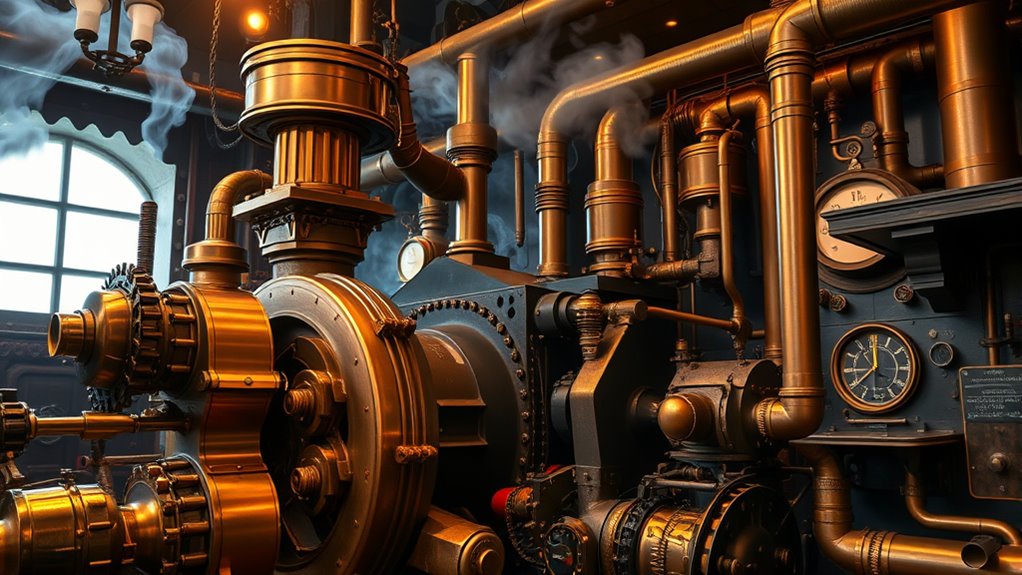
While exploring the fascinating world of steampunk, you can't overlook the pivotal role coal plays in its energy systems.
This genre thrives on the historical inspiration of the 19th century, where coal fueled industrial innovation. In steampunk narratives, coal is often depicted as a symbol of progress, powering advanced steam engines and imaginative machinery that propel airships and urban infrastructure. As with modern energy systems, the importance of efficient energy consumption becomes apparent, showcasing the need for innovation in energy management.
Yet, it also serves as a reminder of environmental degradation, reflecting the societal dilemmas of the time. The stories highlight the quest for efficiency and safety in coal-fired systems, while also hinting at the limitations and challenges that come with reliance on fossil fuels. Additionally, the historical significance of steam power serves as a backdrop for exploring more sustainable energy solutions in contemporary narratives.
Coal represents both progress and peril in steampunk, illustrating the delicate balance between innovation and environmental impact.
Steampunk encourages you to consider the balance between innovation and sustainability in energy systems.
Steam Power: The Heart of Industrial Innovation
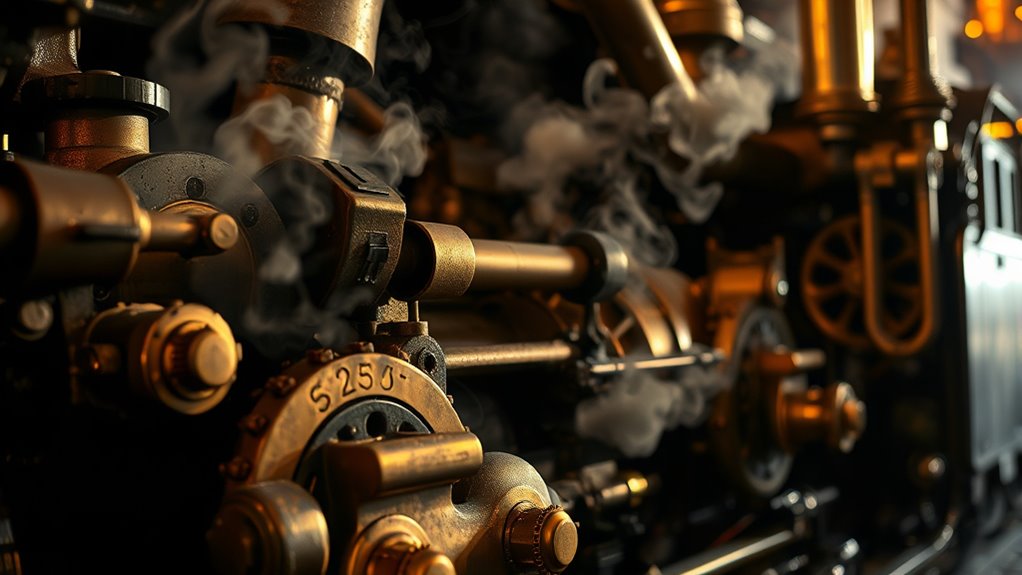
Steam power stands as the cornerstone of industrial innovation, driving the transformation of society during the 19th century. You can trace its roots back to early inventions, with Thomas Newcomen's steam pump in 1712 marking a significant breakthrough.
As technology evolved, James Watt's enhancements, like the separate condenser, boosted efficiency and expanded steam engine applications. This innovation revolutionized industries, from textiles to iron production, enabling mass manufacturing and urban growth. Steam engines improved productivity across multiple industries, allowing factories to be located away from water sources and facilitating greater industrial expansion.
Additionally, steam-powered locomotives and ships transformed transportation, facilitating trade and connecting distant regions. With each advancement, steam power not only increased productivity but also reshaped economic landscapes, making it vital to the Industrial Revolution's success and laying the foundation for modern industry.
Alternatives to Coal: Exploring Fictional Fuels
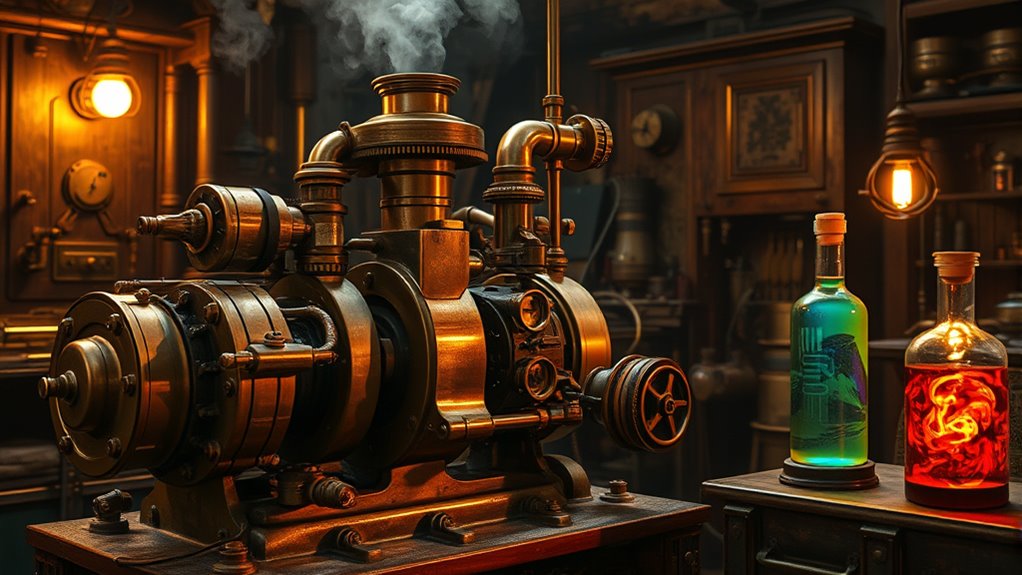
As the industrial age flourished with steam power, imaginative minds began to explore alternatives that could fuel the ever-growing demand for energy.
Aether emerged as a popular choice, a mysterious substance powering advanced devices without coal's environmental toll. This concept echoes the use of steam power in the Creedverse, where it fuels innovative machines and reshapes societal structures. The rise of renewable energy technologies in contemporary discussions reflects similar aspirations for a cleaner future.
You might encounter solar power in some narratives, presenting a cleaner, sustainable future, while wind power becomes a means to propel machines and ships.
Magic often sneaks into these stories, providing a fantastical energy source.
Bioluminescent organisms occasionally light up the scene, showcasing nature's potential.
These alternative fuels not only highlight environmental issues but also spark innovative technologies, reshaping societal structures and encouraging you to reimagine history through a lens of speculative energy solutions.
The Mechanics of Steam Engines
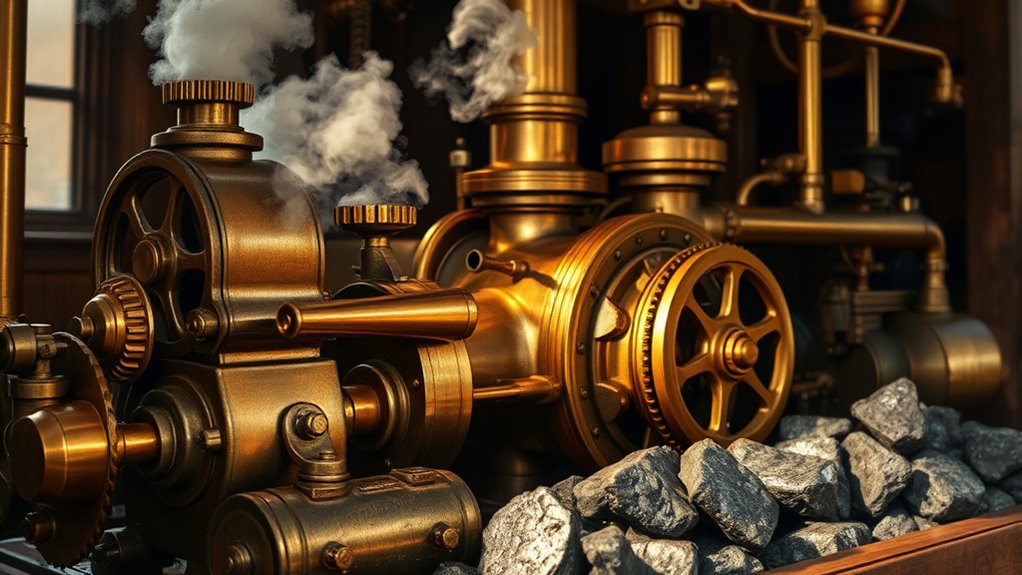
Understanding the mechanics of steam engines reveals how they harness thermal energy to create mechanical work. These engines convert heat from burning coal into high-pressure steam, which then pushes pistons within cylinders.
As steam enters one side of the piston, it expands, driving the piston's movement. Valve systems, like Walschaerts and Stephenson, control steam admission and exhaust, optimizing performance. By adjusting the timing of these valves, you can match operating speed and torque, enhancing efficiency. The boiler generates steam, while the pistons and cylinders transform that steam into mechanical motion.
This ingenious design paved the way for powerful steam locomotives and machinery, revolutionizing transport and industry during the Industrial Revolution. Additionally, the diesel locomotives that followed brought about a new era of efficiency and lower maintenance costs.
Safety and Efficiency in Steam Technology
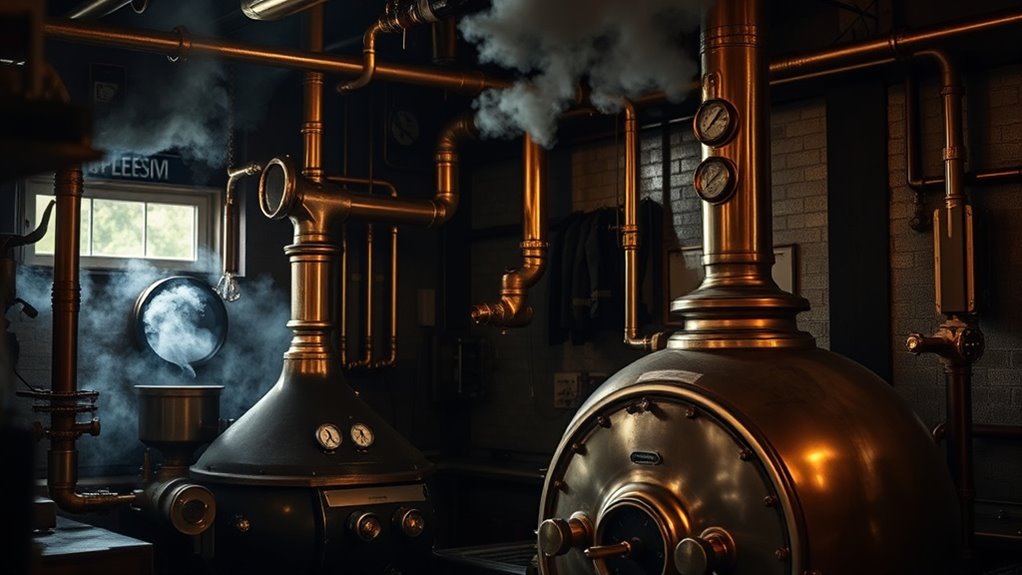
While working with steam technology can be immensely beneficial, safety and efficiency must always be prioritized to prevent hazards and optimize performance.
Slip and fall hazards from condensate leaks can lead to significant injuries, while steam leaks pose burn risks. Neglecting maintenance often results in ruptured pipes, causing both bodily harm and financial losses. Slip and falls account for an estimated $70 billion in workers compensation and medical bills nationally.
Slip and fall incidents from condensate leaks and steam leaks can lead to serious injuries and costly damages.
To mitigate these issues, adopt ultrasonic technology for early leak detection and ensure regular maintenance of steam traps and valves. Insulating pipes reduces heat loss, enhancing efficiency.
Additionally, real-time monitoring through IoT can streamline performance and safety. Implementing heat recovery systems further minimizes energy waste, reinforcing your commitment to safety and operational efficiency in steam systems.
Clockwork Innovations in Energy Generation
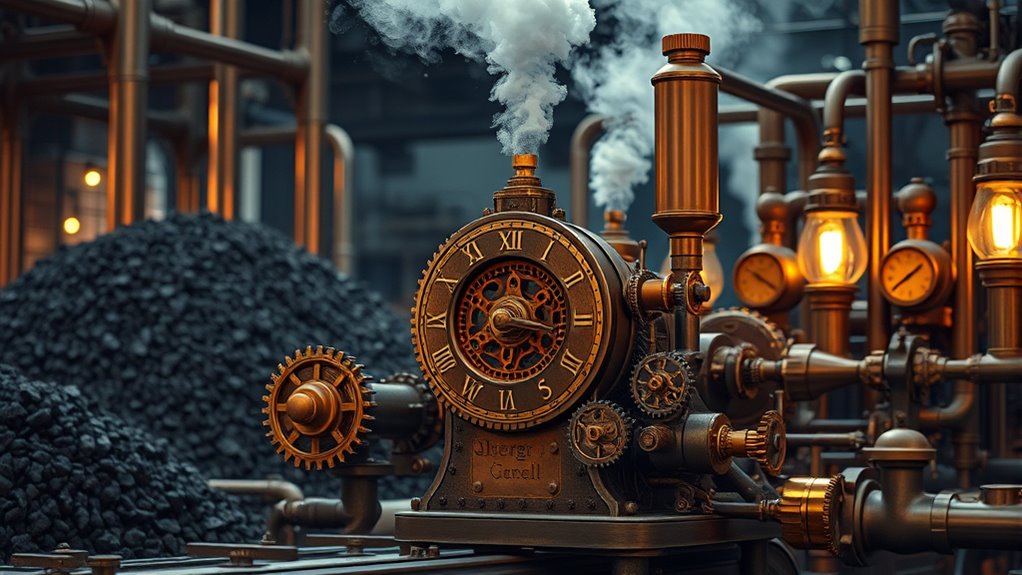
Clockwork innovations in energy generation offer a fascinating blend of mechanical ingenuity and sustainable practices, bringing a unique perspective to energy production. By harnessing the power of springs, these mechanisms store energy much like a battery, releasing it through intricate gears and levers. The precision engineering required ensures smooth operation, making these devices both efficient and reliable. You might find it intriguing how clockwork systems can operate without constant power input, promoting sustainability. Additionally, steampunk fiction often showcases these inventions, integrating them into fantastical worlds where technology and magic collide. Through innovative designs, clockwork devices serve not only as functional energy generators but also as artistic expressions, reflecting the Victorian craftsmanship that inspires their creation.
Airships and the Quest for Lift

Airships have long captured the imagination, blending engineering marvels with a sense of adventure. To achieve lift, these vessels rely on gases like hydrogen or helium, which are less dense than air. Historically, hydrogen was favored for its lifting power, despite safety concerns. After the Hindenburg disaster, helium became the safer choice.
Innovative designs, such as geodesic spheres, enhance structural integrity while allowing for lighter construction. Steampunk airships often feature steam-powered propulsion systems, using lateral propellers for maneuverability. The ability to increase buoyancy through heat energy from the boiler allows for effective lift management, showcasing the intricate mechanics involved in airship operation.
While modern research into vacuum airships holds promise for maximum lift, material limitations still pose significant challenges. Ultimately, airships represent a fascinating blend of historical context and imaginative engineering, inviting you to explore the skies in style.
Aether and Other Fictional Energy Sources

As you delve into the imaginative world of Steampunk, you'll discover that aether and other fictional energy sources play a crucial role in shaping its unique technologies and narratives.
Aether, derived from the concept of luminiferous aether, serves as a mystical energy source, powering everything from rayguns to dimensional travel. This porous substance allows for innovative applications, enhancing storytelling with its mysterious properties.
Alongside aether, you'll encounter other fantastical energy forms, like Eldritch Copper and magical forces, each adding layers to the narrative. These elements spark your imagination, driving the creative potential of Steampunk. Additionally, the use of mechanical devices powered by steam or clockwork gears adds a tangible sense of wonder and complexity to the genre.
Embracing these fictional sources, authors and fans alike explore captivating "what-if" scenarios, enriching the genre with endless possibilities.
Historical Inspirations Behind Steampunk Energy

While exploring the historical inspirations behind Steampunk energy, you'll find that the Industrial Revolution serves as the backbone of this genre's technological imagination. Steam power, particularly the steam engines of the 19th century, became essential to industrial society and remains central to Steampunk narratives. Innovations from the Victorian era, like locomotives and early steam cars, shape the aesthetic and functionality of Steampunk technology. Authors like Jules Verne and H.G. Wells further fueled this fascination, showcasing advanced steam-powered inventions in their works. Coal, as a primary energy source, not only powered these innovations but also poses environmental questions that Steampunk often reflects upon, especially concerning the harmful pollutants released by burning fossil fuels. Additionally, Steampunk's emphasis on DIY culture encourages enthusiasts to create their own imaginative interpretations of steam-powered technology. Together, these elements create a rich tapestry of inspiration for the genre's retro-futuristic vision.
The Future of Energy in Steampunk Narratives

What might the future of energy look like in Steampunk narratives? You could envision a world where steam power coexists with innovative renewable sources like aether and solar energy. Authors might blend Victorian technology with futuristic concepts, creating machines that operate more efficiently than today's systems, potentially utilizing advancements in color accuracy for precise energy allocation. These stories could explore sustainable practices, emphasizing resource management and low energy consumption. In dystopian settings, energy crises might drive conflict, showcasing the consequences of unchecked resource depletion. Alternatively, you might find societies thriving through creative energy solutions, revealing the potential for harmony between technology and ecology. Ultimately, the future of energy in Steampunk narratives invites you to ponder the balance between progress, sustainability, and social impact in an imaginative landscape. The potential for another market crash similar to 2008-2009 could serve as a backdrop for these narratives, highlighting the fragility of resource dependence and the importance of resilience in energy systems. Additionally, integrating solar energy as a primary source could reflect the ongoing quest for sustainable innovations amid traditional power struggles.
Frequently Asked Questions
How Do Steampunk Energy Systems Compare to Modern Energy Sources?
Steampunk energy systems rely heavily on coal and steam, making them less efficient than modern energy sources like solar and fossil fuels.
You'll notice that modern systems offer better scalability and adaptability, while steampunk often features impractical mechanical designs.
Additionally, modern energy sources prioritize environmental considerations, unlike steampunk, which tends to overlook sustainability.
Ultimately, you'll find that modern energy systems deliver more cost-effective and reliable solutions for today's demands.
What Are Common Misconceptions About Steam Power in Steampunk?
You might think steam power in steampunk is all about efficiency and widespread use, but that's a common misconception.
In reality, steam technology had significant limitations and inefficiencies. Many fantastical steam-powered devices you see aren't grounded in historical feasibility.
Plus, the required infrastructure is often overlooked. Instead of just focusing on steam, steampunk should be appreciated for its creative blend of science, fantasy, and the imaginative reworking of history.
Are There Real Historical Influences for Fictional Energy Sources?
Absolutely, there are real historical influences for fictional energy sources. You can see how innovations like steam power and coal mining shaped early industrial societies.
These advancements inspired writers and creators to imagine new energy forms in their works. By blending historical technologies with fantasy, they explore what could've been or might be.
This allows you to engage with both the past and potential futures, fueling your creativity and curiosity about energy's evolution.
How Do Steampunk Narratives Portray Energy Consumption and Sustainability?
As you wander through a bustling steampunk city, the air thickens with steam and the rhythmic chug of machines surrounds you.
Steampunk narratives often portray energy consumption as a spectacle of innovation, showcasing steam-powered factories and fantastical vehicles.
Yet, sustainability takes a backseat; characters rarely ponder resource depletion or environmental impact.
Instead, they revel in technological marvels, with a hopeful, if naive, belief in progress overshadowing any real concern for the planet's future.
What Role Does Fashion Play in Steampunk Energy Technologies?
In steampunk, fashion plays a crucial role in expressing energy technologies.
You'll notice how accessories like brass goggles and mechanical wings symbolize industrial innovation. By wearing clothing with industrial motifs, you reflect the era's spirit of creativity.
Corsets and leather outfits blend Victorian elegance with a rugged aesthetic, showcasing the fusion of history and futurism.
This imaginative style allows you to visualize the "what if" scenarios that steampunk explores, making your outfit a statement of ingenuity.
Conclusion
In the vibrant world of steampunk, energy evolves beyond traditional boundaries, inviting you to envision a future powered by imagination. You've explored the gritty reality of coal and the revolutionary potential of steam, but what if the limits of energy were only defined by your creativity? As you delve deeper into these narratives, consider how these fantastical innovations could inspire real-world solutions. Ultimately, steampunk challenges you to reimagine energy's role in both fiction and our everyday lives.









